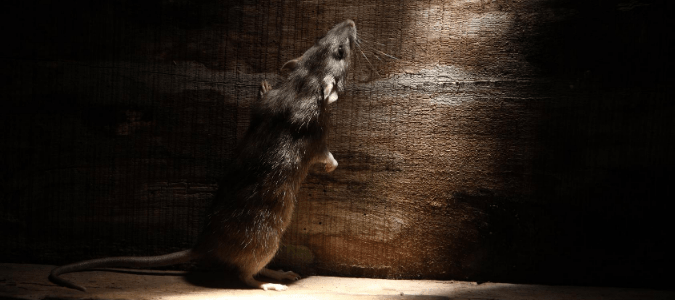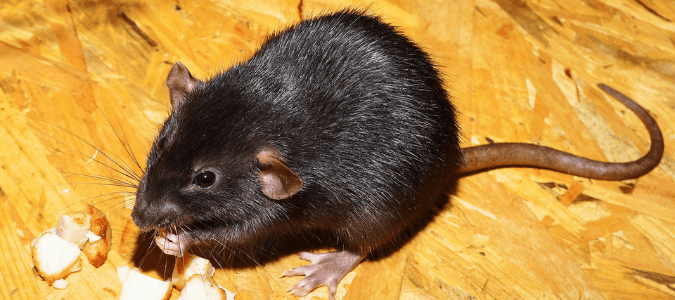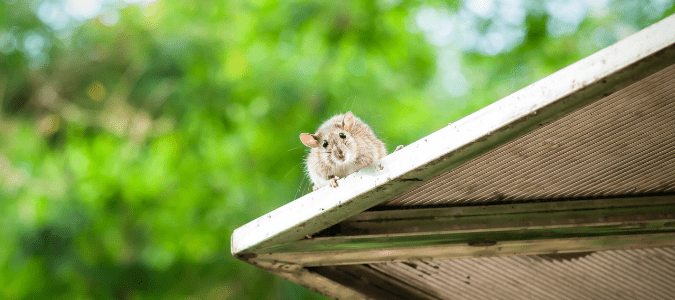Roof rats can cause severe damage to your home and landscaping. They move swiftly through the night to find food and water sources, often gnawing on your walls, pipes, wiring and plants along the way.
It’s important to know how to identify roof rats versus other rat species because they have different habits and diets from other rodents. When you spot a roof rat colony in your home, you need to deal with it right away to avoid further damage, disease and stress to your home and your family.
Keep reading to learn what is a roof rat, how to detect them, their eating habits and how to get rid of an infestation.
What Do Roof Rats Look Like?
Roof rats are easy to recognize because of their extra long tail and slender body. Their sleek fur is either dark brown or black, and some may have white or grey underbelly fur. They also have short snouts and small eyes and ears.
Adult roof rats, also called black rats, weigh between three and eight ounces, and their bodies measure between six and eight inches. Their scaly tails are usually longer than their whole body, measuring between seven and ten inches.
You can tell a roof rat apart from a Norway rat, another common species, by their size and shape. Roof rats are long and lean while Norway rats are shorter and stocky.
Roof Rats Habits and Habitat
As you can tell from their name, roof rats prefer to build their habitats in high places. They are often found on roofs, rafters, attic ceilings, trees and more. They do not burrow underground, but they may nest in lower areas, like shrubs, if there is thick vegetation. Their main criteria is covered shelter, so they may even nest in a wood pile or under a patio.
Roof rats sleep during the day and look for food at night. Once they find a food source, they return to it over and over. It may be hard to spot a roof rat in your home, but you might hear them gnawing inside your walls or in your attic.
Like other rodent species, roof rats have short lifespans. However, in their one-year lifespan, they can reproduce up to 40 times. Roof rats live in colonies of up to ten rats. They are skilled climbers and swimmers, and they typically inhabit homes when the weather gets colder.
How Do Roof Rats Get Inside a Home?
Slender bodies allow roof rats to squeeze through small openings. To get inside your home, they only need a quarter-size opening. Since they are great climbers, they typically climb trees, vines and power lines around your home to find an access point.
While roof rats do nest outside, they like to seek shelter in homes because it protects them from predators and cold weather. Roof rats are hunted by snakes, birds, dogs, cats, possums and other large animals. They also like to live indoors because they can find a food source that is easy to access over and over again.
Since you rarely see roof rats during the day, you need to look for signs of rats by the clues they leave behind. For instance, you can hear them scratching a gnawing inside your walls, and you may see markings where they gnaw around your roof.
If you have fruit trees, hollow fruit is a sign that roof rats have been at work. You may also see rat droppings, grease trails and other markings along their regular routes from their nest to their food and water sources. Another sign of roof rats is if your pets seem more stressed out than usual since the rats take advantage of their food and water bowls.
You may also spot them running quickly along power lines or in trees. They can cause severe damage to your home’s electrical wiring, which is just one of the reasons why you should contact a pest control professional to get rid of these rodents.
What Do Roof Rats Eat?
Roof rats are not picky eaters, which is part of what makes an infestation difficult to control. They are omnivores, which means they will eat meat and vegetables, but they prefer plant-based foods.
Roof rat’s diets consist of:
- Grains
- Nuts
- Seeds
- Cereals
- Fruit (especially berries)
- Garden vegetables
- Plants
- Tree bark
- Animal food
- Slugs
- Native birds
- Fish
- Snails
- Other insects like cockroaches
- And more
For the most part, roof rats will feed on whatever they can find, and they like to hoard their food. They forage for food throughout the night and stash it away in their nest for when they are ready to eat at dusk and dawn. Roof rats like to eat in their shelter to avoid predators.
Since roof rats are also predators themselves, their eating habits can disrupt the native ecosystem. When rats nest outside, they can cause problems when they eat rare birds or fish. They are also enemies of farmers and gardeners because they eat a wide variety of crops and animal feed.
When roof rats live inside your home they will eat basically anything they can find, which is why you should call a professional pest control service to deal with the rodent infestation.
They are not picky about their water source and will drink from leaking pipes, your pets’ water bowls, air conditioning drips, potted plant saucers and more. If they need to, they will eat through plastic and metal pipes to get to a water source.
How Do You Get Rid of Roof Rats
There are several ways to get rid of roof rats, including baiting them into traps. The best bait to use for roof rats is dried fruit and nuts or peanut butter.
Roof rats are wary of predators, so they do not trust new food sources right away. To get them to take the bait, put it out on the trap without setting the trap back at first. After a few days they will trust the food source, and then you can set the trap.
To make traps even more effective, you will want to limit the amount of food available to them. Regularly wipe down counters and sweep, and put trash in containers with tight fitting lids. Move foods like cereal into containers with lids that rats won’t be able to chew through. Also, be sure to clear pet food and water bowls before going to bed at night.
There are three common types of rat traps: snap traps, electronic traps and glue traps. Snap traps are effective at killing rats, and they are reusable and disposable. They trap one rat at a time, so you will need to set out several to take care of the entire population of roof rats in your home.
Electronic traps are considered to be more humane because they kill the rat with an electric shock. They are safer to use around pets and children, and they trap the rat inside the trap so that you do not have to see the dead body.
Instead of using bait, glue traps capture rats along their running route. You can place them along your walls or other areas where you’ve seen roof rat activity.
Once you deal with a roof rat population in your home, it’s important to keep them from entering again. Seal up any holes and crevices that are the size of a quarter or larger. Use screens on your roof vents, attic vents and the fireplace opening. You should also maintain proper window screens so that these pests can’t sneak in.
Keep trees, vines and shrubbery near your home trimmed back to give roof rats fewer climbing opportunities. Avoid stacking wood piles or storage boxes against your home since roof rats often use them for shelter.
Roof rat colonies are hard to get rid of once and for all on your own, which is why it’s important to enlist professional help. A pest control specialist can get rid of the pest infestation, identify and close up their entry points and offer more tips to prevent a roof rat colony from damaging your property in the future.
If you see one roof rat in your home, chances are there is a whole colony hiding in high places like your roof, attic or garage. Roof rats can cause structural damage and transmit diseases, so it’s important to deal with them right away.
There are several methods and preventative measures you can take to avoid roof rat damage yourself. However, you should also call in an expert to get rid of the problem for good. A pest control specialist will have the right tools and tactics to eradicate roof rats in your home and protect your property.
ABC Can Control the Rodents on Your Property
It can be difficult to identify the signs of rodents on your property and even more difficult to actually control the rodents. If you suspect you have unwanted visitors on your property, contact ABC Home & Commercial Services. Our team will be able to come up with an effective pest control plan, so you don’t have to deal with any more rodents.



